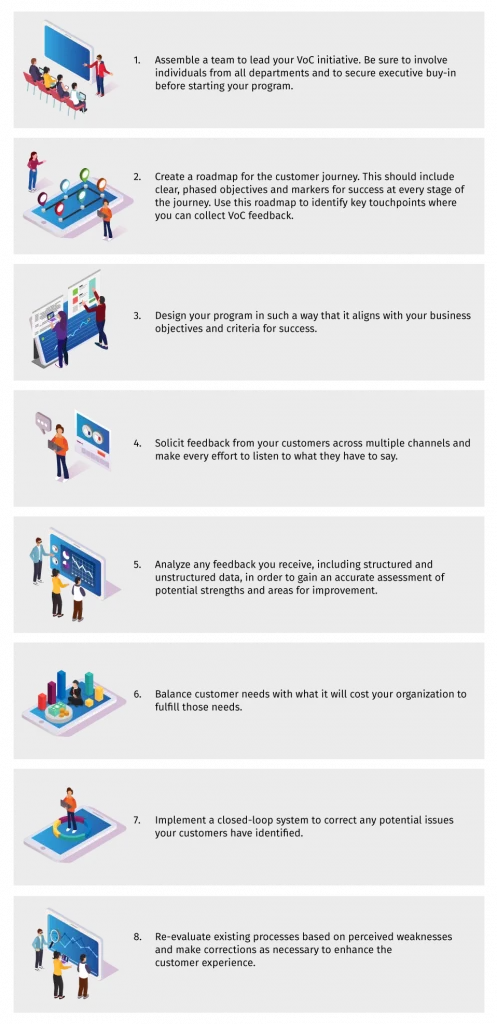

When it comes to technology, Apple is one of the most recognizable and influential brands in the business, known for its sleek designs, innovative products, and exceptional customer experience.
Apple co-founder Steve Jobs learned the value of customer early on. During a presentation at the 1997 Worldwide Developer Conference, Jobs said that:
“One of the things I’ve always found is that you’ve got to start with the customer experience and work backwards to the technology. You can’t start with the technology and try to figure out where you’re going to try to sell it. […] As we have tried to come up with a strategy and a vision for Apple, it started with, ‘What incredible benefits can we give to the customer? Where can we take the customer?’”
Jobs’s message is one that organizations across every industry should take to heart. Customer experience is the new competitive battlefield; in order to maintain market share and get ahead, companies must heavily factor customer experience into everything from product development to sales and marketing strategy. In order to do that, though, organizations must start by listening to the Voice of the Customer.
Glossary
Before we get started, let’s review some terminology related to Voice of the Customer.
- Voice of the Customer: Called VoC for short, Voice of the Customer refers to the process by which businesses capture customer perceptions in order to gain firsthand perspective into what the customer experience is like, and how consumers are talking about their brand, product, or service. In doing so, businesses also gain a more holistic view into what their target audience wants, needs, and expects. There are any number of ways to approach this process, including running focus groups, conducting customer surveys, evaluating social sentiment, and reading customer reviews.
- Customer Perceived Value: Customer perceived value refers to the value that customers assign to a product or service based on whether they believe it will meet their needs or expectations. Typically, when determining the perceived value of an item, customers will weigh its perceived benefit against its perceived cost. If the perceived benefit outweighs the perceived cost, the item will have a positive customer perceived value; if the inverse is true, the item will have a negative customer perceived value. The customer perceived value of a product or service is dependent on a number of factors, including its actual price and reputation; that said, if a business is able to convince consumers that its product or service is a triple threat — that is, that it offers physical, logical, and emotional benefits — it’s likely to secure a high customer perceived value.
- Customer Journey: Customer journey can refer to one of two similar, but slightly different, processes, depending on the perspective from which you look at it. From the consumer’s perspective, the customer journey describes the entire buying process, starting with initial awareness of a need or a problem and ending with a purchase. From a business perspective, the customer journey is the complete sum of experiences a customer has with their brand. As a result, this version of the customer journey tends to be longer because it extends all the way from the consumer’s first interaction with marketing materials to ongoing efforts from the business to retain that customer and turn them into a brand advocate. To that end, companies must take care to nurture the customer at every stage of the journey in order to win not only their short-term business, but also their long-term loyalty.
- Moments of Truth: Moment of truth is a marketing term used to describe a pivotal moment in the customer journey in which a consumer forms their opinion of a brand, product, or service. The moment of truth is most commonly the consumer’s first interaction with a brand, product, or service, however, some sources claim that there are as many as five moments of truth in the customer journey, including when the consumer researches a product prior to purchase and when the consumer (now customer) provides feedback on the product or service.
- Market Research: Market research describes the collective efforts an organization takes to gather information about its target audience, specifically their needs and preferences. Market research typically falls into one of two main categories: primary research and secondary research. The process of conducting primary research is similar to capturing the Voice of the Customer in that it involves using phone interviews, online surveys, focus groups, and so on to collect information. Secondary research requires a business to review documentation from both internal and external sources — market reports, sales data, thought leadership articles, and so on — and draw conclusions from there.
- Qualitative Research: Qualitative research is a research methodology that involves the analysis of unstructured and non-numerical data, such as text, video, or audio. With Voice of the Customer, qualitative research data might take the form of survey and interview responses, audio recordings from focus group sessions, and so on.
- Quantitative Research: Quantitative research is a research methodology that involves the analysis of statistical and numerical data. With Voice of the Customer, quantitative research data might take the form of yes/no questions, customer rankings, CSAT and NPS scoring, and so on.
- Product Development: Product development refers to the process by which businesses bring a product from a concept or idea to a tangible item. The traditional new product development lifecycle consists of eight stages: Idea Generation, Idea Screening, Concept Development, Business Strategy Development, Product Development, Test Marketing, Commercialization, and Introduction.
The Impact of Voice of the Customer on Business
By now, you’ve likely heard numerous industry publications and thought leaders tout the importance of customer experience — perhaps even to the point where it seems tiresome. But CX has become a buzzword for good reason: According to one oft-cited statistic, 89% of companies report to competing on the basis of customer experience. According to another, more recent report, experience-driven companies are able to increase revenue 1.4x more than other companies; those same companies were also able to increase customer lifetime value 1.6x more than other companies. By 2020, CX is expected to overtake price and product as the key brand differentiator.

Given the vast opportunities CX presents and the significant impact it has on business, it’s a bit easier to forgive various outlets for talking about it ad nauseam.
This also why Voice of the Customer is so important — without a concrete understanding of customers’ motivations and desires, it’s nearly impossible to deliver an experience that not just meets but completely exceeds their expectations. And that’s just one benefit; by implementing a Voice of the Customer program in your organization, you can also:
- Identify potential brand crises before they take place. Even something as simple as a single negative product review can point to a larger issue. By monitoring present public sentiment about your brand product, you can identify potential problems before they have the chance to turn into a full-blown crisis. In addition to supporting crisis prevention, you can also leverage Voice of the Customer for crisis management. In the immediate aftermath of a major event, keep an ear to the ground and listen to what people have to say about your brand’s response, how they’ve been affected, and whether they believe you’ve successfully resolved the issue at hand.
- Test out new concepts and ideas. Have an idea for a new product or service, but don’t want to invest in a full product development lifecycle until you know, with relative certainty, that it’ll be a success? Put it to the test with Voice of the Customer! Solicit feedback on new concepts and ideas from your existing customer base to see whether they have a chance of taking off or will be dead on arrival.
- Give customers what they actually want. Rather than simply guess at what your customers want and risk disappointment, go directly to the source. One of the key benefits of VoC is that it provides an accurate look at how customers think and feel, what pain points they need resolved, and what they want and expect from a brand, product, or service.
- Increase customer retention — and revenue. By consistently delivering goods and services that align with expectations and resolve common challenges, you’re more likely to win customers’ long-term business and increase your profit margins accordingly.
Common Voice of the Customer Techniques & Questions
We’ve already mentioned some common Voice of the Customer data collection techniques you can implement in your business, but let’s look at a few more:

Once you’ve determined which techniques to leverage, the next step is to come up with a series of questions to ask customers to get a sense of how they think and feel. Here are some sample questions to help you get started:
Demographic Questions
- What gender do you identify as?
- What is your age?
- Where do you live?
- What is the highest degree or level of education you have completed?
- What is your current employment status?
- What is your marital status?
General Questions
- What level of expertise do you have in [relevant subject area]?
- How do you prefer to learn (reading, listening, watching, etc.)?
- What is your preferred method of communication (email, phone, text/SMS, etc.)?
- What characteristics do you look for in a company/product?
- What are the biggest challenges you currently face?
- How can we help you overcome those challenges?
- What product/service do you wish someone would create?
Product/Service Questions
- What comes to mind when you think about [company name/product name]?
- Which of our products or services do you currently use?
- Why did you choose our company/product over the competition?
- Are there any other companies whose product(s) you prefer over ours?
- If so, why?
- Can you provide an example of how you’ve benefited from using our product/service?
Satisfaction Questions
- On a scale of 1–5, with 1 being “Not at All Satisfied” and 5 being “Very Satisfied,” how satisfied are you with our products/services?
- Would you recommend [company/product]?
- Why or why not?
- How can [company name] improve your customer experience?
- What can our company do to better serve your needs?
- What else would you like us to know?
How to Implement a Voice of the Customer Program
When developing and implementing a Voice of the Customer program, there are a few basic steps to follow:

What to Look for in a Voice of the Customer Solution
There are numerous VoC tools and solutions on the market today, each with its own set of advantages and disadvantages. Whether you’re small-to-medium-sized B2C company or an enterprise-level B2B business, we’ve compiled this list of questions to help you evaluate various solutions and find the VoC tool that’s right for you:
- Does this solution store data in a centralized repository?
- Does this solution integrate with the technology our organization currently uses?
- Does this solution make it easy to share data with key stakeholders?
- Will this solution enable us to custom configure role-based dashboards?
- How difficult will it be to train our employees to use this solution?
- Will this solution enable our customers to provide feedback through whatever channel is most convenient for them?
- Does this solution combine structured and unstructured feedback in order to create a holistic view of the customer?
- Does this solution support interdepartmental collaboration?
- Does this solution incorporate employee feedback in order to provide valuable context to the customer experience?
Hitachi Solutions & Microsoft Dynamics 365 Customer Voice
Microsoft recently released Dynamics 365 Customer Voice, a real-time feedback management solution that, according to Microsoft General Manager Brenda Bown, is “designed to empower businesses and organizations to build better products [and] deliver better experiences to customers.”
Customer Voice includes an exciting array of features and capabilities, including:
- Premade, easy-to-personalize survey templates
- Custom-configured dashboards for real-time reporting
- Automated KPI monitoring for built-in satisfaction metrics
- Tight integration with the entire D365 application suite and Power Platform
- And more
If you’re interested in discovering all that D365 Customer Voice has to offer, Hitachi Solutions is offering a one-day Customer Voice Enablement workshop. In this workshop, you’ll learn how to leverage Customer Voice to generate real-time insights that enhance the customer experience. You can sign up for the workshop by following this link.
If you have any other questions about Voice of the Customer, including how to get started creating and implementing a VoC strategy, Hitachi Solutions is here to help. Contact us today to find out what we can do for you.
Video: Become a Customer Service Self-Service Superhero!
Come learn about the evolving suite of Customer Service solutions available on the Power Platform and how these technologies can make you a superhero in the eyes of your customer.https://play.vidyard.com/WGvV2eWZR8wLUkkorv5iBF.html?


